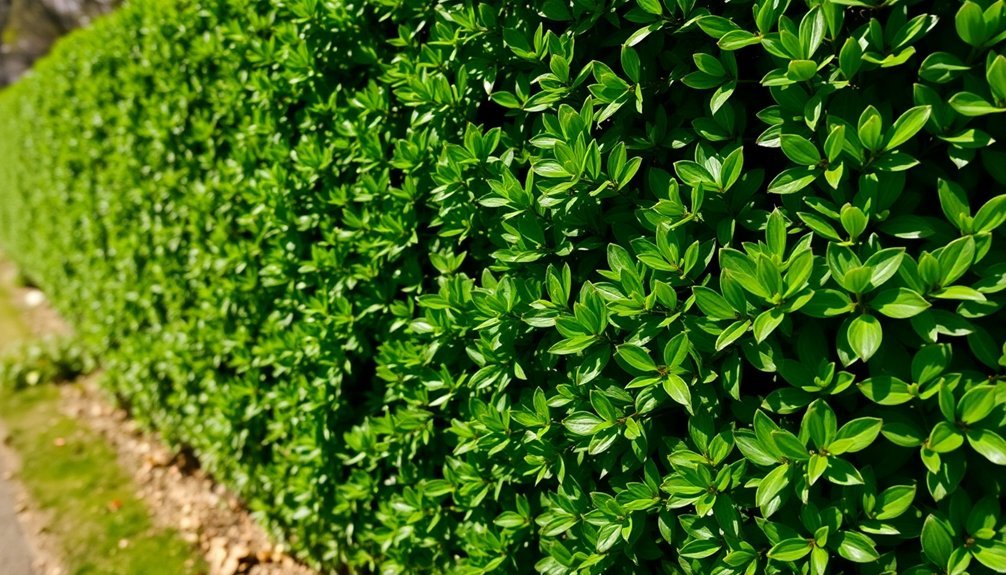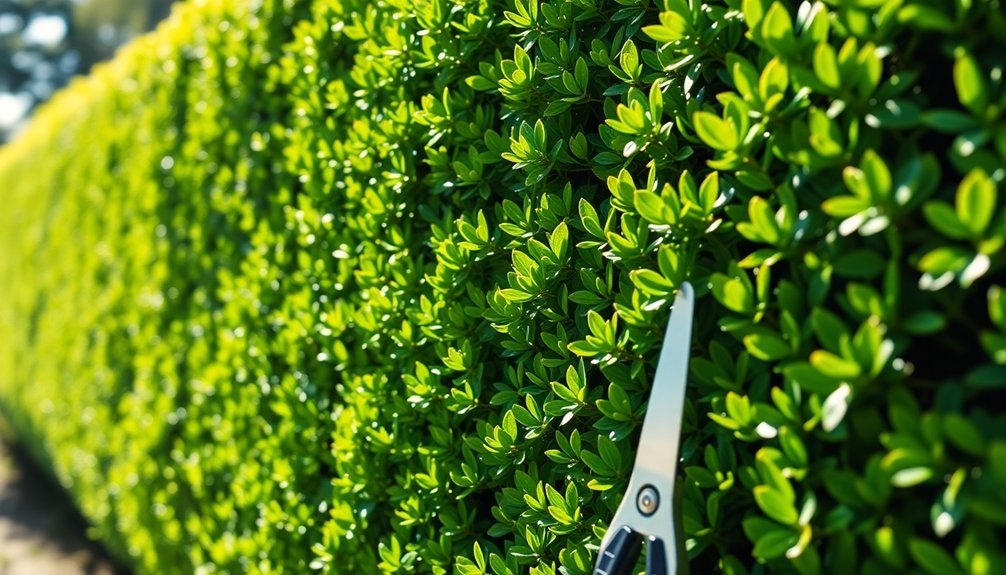The ideal privet hedge trimming schedule includes major pruning in early May to remove dead branches and shape the hedge, followed by light trimming in early June for directional growth. During peak growth in July-August, maintain a tapered shape with tops narrower than bases. Stop heavy pruning by late August to allow hardening before frost. Apply mulch in fall for insulation. This seasonal approach guarantees your privet remains healthy and attractive throughout the year.
Understanding the Growth Cycle of Privet Hedges

While establishing a beautiful garden boundary, understanding your privet hedge's growth cycle is essential for proper maintenance.
Privet hedges grow vigorously, typically 30-60 cm annually, and reach full development within 3-5 years after planting.
These adaptable plants thrive in various environments from full sun to partial shade, though they prefer at least six hours of direct sunlight daily.
During summer, privets produce white flowers followed by black berries.
Winter serves as their dormancy period, making it ideal for major pruning work.
Your hedge's growth rate will vary depending on climate conditions, species type, and care practices.
Consistent moisture helps establish strong roots, while regular pruning promotes dense growth.
The glossy, oval leaves measuring approximately 2.5-5cm long create a dense foliage screen that effectively blocks unwanted views.
With proper maintenance, your privet hedge can remain aesthetically pleasing for 30-40 years or more.
Spring Pruning: Timing and Techniques
Early May offers the perfect opportunity to rejuvenate your privet hedge with a thorough spring pruning session.
You'll want to cut back any dead branches first, removing up to one-third of the plant to stimulate vigorous new growth.
For established hedges, focus your cutting efforts more heavily on the top than the sides to maintain that essential sloped shape that allows sunlight to reach lower branches. Ensure your tools are clean and sharp before beginning your pruning work to achieve the best results.
Early May Timing
For many gardeners, May marks the perfect opportunity to give privet hedges their first significant trim of the season. This timing aligns perfectly with the plant's growth cycle—occurring after the final frost but before summer's vigorous growth spurt.
| Pruning Factor | Early May Benefit |
|---|---|
| Weather | Mild conditions ideal for plant recovery |
| Growth Stage | Before major new growth begins |
| Bird Nesting | Check carefully before cutting |
| Recovery Time | Plenty of growing season remains |
| Vigor | Stimulates dense, fuller regrowth |
You'll notice your privet responds with healthy new shoots when pruned in early May. While spring pruning is beneficial, some experts recommend a follow-up summer pruning in July for optimal results. The timing strikes the perfect balance—not too early to risk frost damage, not too late to miss the opportunity to shape spring growth. Remember to confirm no birds have made their home in your hedge before starting.
Rejuvenation Cutting Techniques
When a privet hedge becomes overgrown, sparse, or unmanageable, rejuvenation cutting offers a dramatic but effective solution. This technique involves cutting the entire hedge back to within 12 inches of the ground, best performed in late winter to early spring before new growth begins.
You'll need sharp loppers and pruning shears for thicker branches. This severe pruning encourages robust new growth while eliminating dead or diseased sections.
After cutting, support recovery by applying fertilizer and mulch around the base. The privet shrubs will quickly re-sprout vigorously after this hard cutting, typically showing significant recovery within one growing season.
For safety, always wear gloves to protect against privet sap's irritating properties, and sterilize your tools between cuts to prevent disease spread.
While this approach temporarily sacrifices your privacy screen, the hedge will return fuller and healthier, with improved structure and air circulation.
Summer Maintenance for Dense Foliage

You'll want to shape your privet hedge in early June to maintain its tidy appearance after spring's rapid growth.
A light trim now helps control the direction of new growth while promoting denser foliage throughout the season.
For the healthiest results, focus on removing just the tips of branches rather than cutting deeply into the hedge during summer's heat. The best approach is to trim regularly between May and August to maximize growth potential and strengthen the shrub for winter.
Early June Shaping
The early June pruning session stands as a critical maintenance period for privet hedges, ensuring they develop the dense, lush foliage that makes them so desirable.
After the initial spring growth, you'll want to trim your hedge to maintain its shape while being careful not to disturb nesting birds.
Use sharp garden shears for individual branches or electric trimmers for larger sections, always cutting at a 45-degree angle just above leaf buds.
Keep your hedge tapered—wider at the base than the top—to allow sunlight to reach all parts.
Remove any dead or diseased branches you spot during this process.
This strategic June shaping stimulates denser regrowth and maintains a neat appearance.
Remember to apply fertilizer afterward to promote healthy new growth throughout the summer months.
This early summer timing aligns perfectly with the recommended twice a year pruning schedule that professionals suggest for optimal privet hedge health and appearance.
Midsummer Growth Control
Midsummer represents the crucial period for controlling your privet hedge's explosive growth, particularly during July and August when growth rates peak.
With privet capable of adding up to 30 cm annually, you'll need strategic trimming to maintain both shape and density.
- Trim the top slightly narrower than the base, creating a sloped shape that allows sunlight to reach lower branches.
- Cut stems at a 45-degree angle just above leaf buds to stimulate dense, healthy growth.
- Remove flowers before they seed to prevent your hedge from becoming invasive.
- Water deeply during dry periods while monitoring for pests like aphids.
Don't over-prune during summer heat—this stresses the plants.
Instead, use sharp, clean tools and consider staggered pruning of new shoots to maintain vigor while focusing on top trimming to encourage robust side growth for a fuller, more attractive hedge.
Fall Preparation: Getting Your Hedge Ready for Winter
As temperatures begin to drop and leaves change color, preparing your privet hedge for the approaching winter becomes vital to guarantee its health and vigor next spring.
Stop heavy pruning by late August, giving your hedge time to harden off before frost arrives.
Offer your privet a final light trim in late August to maintain its shape, but avoid cutting back after this point.
Apply organic mulch around the roots to retain moisture and provide insulation.
If you're growing privet in containers, move them to sheltered locations or wrap with burlap for protection.
You'll want to reduce watering frequency as soil stays moist longer in cooler weather.
Always make certain your pruning tools remain sharp and clean to prevent disease transmission during these final maintenance sessions.
Fall is an important time to avoid pruning as new growth would be susceptible to frost damage during winter months.
Year-Round Monitoring and Care Guidelines

Maintaining a beautiful privet hedge requires consistent attention throughout the changing seasons, not just during scheduled trimming periods.
Regular inspection helps you catch potential issues before they become major problems.
- Monthly inspections – Check for signs of disease, pest infestations, or damage. Remove dead or diseased branches promptly to prevent spread and maintain hedge health.
- Seasonal growth assessment – Monitor growth rates during spring and summer months when privet grows fastest, adjusting your trimming schedule accordingly. Apply a balanced, slow-release fertilizer in early spring to support optimal growth and hedge density.
- Weather preparation – Protect new growth from extreme weather conditions and avoid pruning during frost periods or intense heat.
- Tool maintenance – Clean and sterilize your pruning tools regularly to prevent disease transmission between plants and guarantee clean cuts that heal properly.
Tools and Equipment for Effective Hedge Trimming
The right tools make all the difference when trimming your privet hedge, ensuring clean cuts that promote healthy growth while saving you time and effort.
For routine maintenance, quality hedge trimmers are essential, while secateurs and pruning shears handle precise cuts and remove diseased branches.
Don't overlook safety equipment—always wear protective gloves to guard against thorns, eye protection for flying debris, and appropriate footwear. For comprehensive protection, remember to use ear defenders when operating power tools like hedge trimmers and chainsaws.
Safety first: protect your hands from thorns, shield your eyes, and wear sturdy shoes while pruning.
When working with taller hedges, use step ladders cautiously or invest in telescopic pruners for safer access.
Make cleanup easier by spreading tarpaulins beneath your work area to catch clippings.
Consider adding pruning saws for thicker branches and blade cleaners to maintain your tools' effectiveness between trimming sessions.
Special Considerations for Young vs. Mature Privet Hedges

Young and mature privet hedges require distinctly different care approaches throughout their lifecycle. Understanding these differences helps guarantee your hedge develops properly and maintains its health for years to come.
- Pruning frequency – Young hedges need several trimmings per year to establish density and shape, while mature hedges typically require only one or two annual prunings.
- Seasonal timing – Trim young privets in early spring to encourage branching, while mature hedges benefit from late autumn pruning to prepare for winter. Avoiding summer pruning is advisable as it can disrupt nesting birds and remove beneficial flowers.
- Cutting depth – For young plants, remove about half of new growth; mature overgrown hedges can be cut back to 6 inches from ground level for rejuvenation.
- Tool selection – Use sharp hand shears for young hedges, but switch to loppers and pruning saws for thicker branches in established hedges.
Balancing Aesthetics and Health in Your Trimming Schedule
Successful privet hedge care requires striking a delicate balance between aesthetic appeal and plant health when planning your trimming schedule.
For formal hedges, maintain flat tops and slightly sloping sides to guarantee sunlight reaches the lower branches, preventing bare spots that compromise both appearance and vigor.
Focus your major trimming efforts in late winter or early spring when the plant can recover effectively. When performing a hard prune, cut back approximately within 30cm of the ground to encourage robust new growth.
You'll achieve denser growth by trimming regularly but lightly rather than infrequent heavy cuts.
During summer, limit yourself to minor aesthetic adjustments while being mindful of nesting birds.
Support your trimming schedule with proper nutrition, mulching, and consistent watering to encourage healthy regrowth.
Remember that your most attractive hedge is also your healthiest one—dense, evenly shaped, and free of disease.
Troubleshooting Common Privet Hedge Growth Issues

Despite diligent maintenance, privet hedges often develop issues that can compromise their appearance and health. Identifying and addressing these problems promptly will guarantee your hedge remains vibrant and structurally sound.
Even the most carefully tended privet hedges face inevitable challenges requiring swift intervention to maintain their beauty and integrity.
- Pest infestations – Look for vine weevil damage, spider mite webbing, or aphid colonies. Apply biological controls or appropriate insecticides when needed.
- Disease management – Watch for powdery mildew, rust, or the deadly honey fungus. Remove infected plants entirely if honey fungus appears.
- Overgrowth correction – Trim at least twice yearly to prevent legginess. Cut back top growth to encourage density at the base. Proper pruning technique includes cutting terminal buds at a 45-degree angle to promote healthier and more vigorous growth.
- Environmental stress – Address drought with consistent watering, improve drainage in wet areas, and apply mulch to regulate soil moisture and temperature.
Frequently Asked Questions
Can I Prune During Flowering to Preserve Privet's Fragrant Blooms?
No, you shouldn't prune during flowering. It'll remove current blooms and potentially damage next year's buds. Wait until after flowering completes to prune, which preserves the fragrant blooms and supports pollinators.
How Do Hedge Height Regulations Affect Privet Trimming Schedules?
You'll need to adjust your trimming schedule to comply with local height restrictions. Trim more frequently during growing season, typically adding 1-2 extra cuts yearly to stay under regulated heights and avoid penalties.
Will Trimming Schedule Changes Help Reduce Privet's Invasive Tendencies?
Yes, you'll reduce privet's invasiveness by trimming twice yearly in early spring and late autumn. Regular summer maintenance pruning and selective peripheral trimming will control overgrowth and limit its spread into adjacent areas.
Can Privet Hedges Recover From Severe Neglect or Overgrowth?
Yes, you can revive neglected privet hedges through rejuvenation pruning. Cut them back to about 12 inches during winter dormancy, and they'll bounce back with new growth in spring with proper care.
How Should Trimming Schedules Adjust During Drought Conditions?
During drought, you'll need to trim less frequently. Reduce summer pruning to minimize stress, guarantee you're watering adequately, and avoid heavy cutting. Maintain mulch to preserve moisture and postpone major pruning until conditions improve.
In Summary
By establishing a consistent trimming schedule for your privet hedge—spring shaping, summer maintenance, and fall cleanup—you'll create a healthy, attractive boundary that enhances your landscape. Remember to adjust your approach based on your hedge's age and growth patterns. Don't forget to keep your tools sharp and sanitized between uses. With regular attention and proper technique, your privet hedge will thrive for years to come.





Leave a Reply